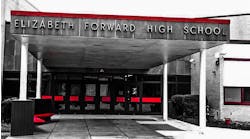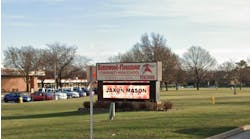For education administrators, campus fires are not only a distressing loss, but also a stark reminder that a campus faces risks that require special vigilance.
In many ways, campuses resemble small communities, with areas for living, working and relaxing. A residence hall fire may raise the specter of careless youth, often with the complication of alcohol thrown in. But fire-safety concerns also center on classrooms and faculty offices, where tinder-dry books and papers are abundant. Throw in irreplaceable special collections in university libraries, valuable fine-arts exhibits and historic buildings, and it becomes clear that fire prevention requires comprehensive planning beyond rules about residence hall living.
Now, with new efforts at the federal level to track campus fires, administrators should take a fresh look at their fire-prevention efforts. Although many fire-safety steps fall under the category of common sense, others require specialized knowledge. An insurer that provides comprehensive coverage and a suite of services may provide education administrators a resource of risk-control experience.
The scope of a threat
Understanding any risk typically begins by knowing how likely a problem is to occur. There is no study specific to college and university fires, but statistics from various studies performed by the National Fire Protection Association (NFPA) that apply to education institutions indicate opportunities for improved fire safety.
In its report on structural fires on education property for the years 2002 through 2005, the NFPA includes elementary and secondary schools. The closest accounting for college and university fires is a mixed category labeled “adult education centers and college classrooms.” For that category, the report identifies an average of 730 fires per year, which accounted for an annual average of 14 injuries and $25 million in property damage.
In a separate report for the same timeframe, NFPA found an average of 3,300 fires occurred each year in residence halls (including K-12 schools with boarding facilities), fraternities, sororities and barracks. These caused an average of seven deaths and 46 injuries each year, as well as $25 million in property damage.
An NFPA researcher notes that fires that may occur on college and university campuses in structures that are neither classrooms nor residence halls are not captured by the reports. In addition, fires not reported to municipal fire departments are not included.
In both reports, the leading cause of fires was cooking equipment (accounting for 72 percent of the fires in the residence hall report and 25 percent in the all-schools report), followed by contained trash fires (7 percent and 25 percent, respectively) and arson (4 percent and 22 percent, respectively). In the residence hall report, lighted tobacco products and candles each caused only 2 percent of fires, but together accounted for almost two-thirds of the deaths. For all education property, intentionally set fires caused the most injuries and the most property damage.
One aspect of data collection is expected to improve because of a late-night fire in January 2000. Two young men finished a night of drinking by setting fire to a “Welcome Back” banner in a residence hall lounge at Seton Hall University in New Jersey. The fire spread to a couch and from there became an inferno that killed three students and injured more than 50 others.
In the outcry that followed, the U.S. Congress made fire-incident reporting for student residence halls a new requirement for colleges and universities when it reauthorized the Higher Education Act in 2008. In addition to reporting fires, campuses will be required to describe the presence of fire-protection equipment; fire-safety training programs; and the number of regular mandatory fire drills. Final regulations to complete this and other portions of the act are expected to be published in November 2009.
A sound plan
With the onset of federal tracking of fire-safety provisions at campuses, now is an excellent time for administrators to review the plans they have in place, assess any shortcomings and work with risk-control specialists to improve fire-prevention efforts. There are three areas on which to focus:
- Prevention
An effective fire-prevention program should be tailored to an institution's specific conditions, but in general should have four key elements: rules that limit the potential for fire; education and training that alerts everyone about the rules; regular inspections to ensure the rules are being followed; and enforcement of consequences to encourage compliance.
Because studies indicate cooking is a leading cause of fires, administrators need to encourage vigilance about residence hall rules concerning hot plates, popcorn poppers and other heat sources that students may use to prepare food. Similarly, halogen lights, frayed extension cords, flammable decorations, tobacco products and candles can be dangerous in any setting, but particularly in residence hall rooms. With arson fires causing the most injuries and property damage, good campus security will be key to preventing fires, including good lighting and supervision outside and effective access control to interiors.
Administrators also should educate staff about the role that alcohol plays in many fires. Students who drink to excess can become careless with flammable materials, be unable or hesitant to properly alert authorities when a fire breaks out, and have difficulty following directions if an evacuation of a burning building is required. In addition, student apathy in the face of what they may consider to be a drill or a prank can be a problem when a real fire alarm is set off.
- Protection
Along with many fire-protection features and equipment, campuses should include smoke-detection devices wired into the electrical system, a centralized monitoring system and automatic sprinklers.
Central monitoring already has been adopted widely. The National Association of College and University Business Officers reported that in September 2008 a large majority of its members have all or most of their campus facilities centrally monitored for fire alarms, and more than three-quarters of residence halls are monitored centrally.
Automatic sprinklers, which can be expensive, are less prevalent. They can make a substantial difference. The NFPA noted in its residence hall report that in the 36 percent of fires in buildings with automatic-suppression systems, deaths and property damage were far less than in buildings without the equipment (zero vs. 13.9 deaths per 1,000 fires and $3,800 vs. $35,000 in average losses). For academic buildings that are unattended at night, burglar-alarm systems and closed-circuit TV monitoring are important deterrents to vandalism and arson.
Campuses also should ensure the equipment is functioning. Maintenance and testing should be carried out regularly.
- Insurance services
Education administrators can benefit from an insurer that provides services in fire prevention and readiness. For example, a risk-control department should be available to conduct site surveys, provide guidance and plan reviews for new projects, and offer on-campus training, webinars and other prevention resources.
In addition to standard business policies, administrators may want to consider extended coverage, such as a business-continuity policy to cover the costs of using alternative sites in the event of fire damage. Policies should cover special collections, such as library resources, artwork and other university assets.
The threat of fire can be devastating for an education institution. By working closely with experts, administrators can create an effective prevention plan and improve the odds against a destructive fire.
- Read the "K-12: Playing with fire" sidebar to learn why K-12 schools are in danger of arson.
- Read the "Precautions in residence halls" sidebar to learn about recommendations for dealing with fire prevention and suppression in residence halls.
Denker is the industry manager for educational institutions for Travelers Commercial Accounts. She can be reached at [email protected]. West is the manager of the Home Office Fire Specialists for Travelers Risk Control. He can be reached at [email protected].
Related Stories
K-12: Playing with fire
Although a college campus can be a fire-hazardous environment of youthful carelessness exacerbated by alcohol impairment, K-12 schools have proven to be more likely settings for arson. The National Fire Protection Association has reported that almost a quarter of all fires in education properties are set intentionally, compared with a much lower 4 percent incidence of arson in college residence halls.
Elementary and secondary school administrators need to plan their prevention measures around the contributing factors that make their facilities so vulnerable.
Some factors can only be understood but not prevented. For example, the U.S. Fire Administration notes that half of all arson arrests involve juveniles — the population served by K-12 schools. The reasons are many: Young people are prone to experimenting with lighters, firecrackers and other incendiary material. They often have poor impulse control, especially when gathered with a group of like-minded friends. They also may lack the maturity to think through the consequences of their actions.
Other factors at K-12 schools, however, can be addressed by security measures. Many schools feature open designs on large lots, providing multiple points of entry. They may have low roofs that are easy to climb on to. They often are deserted for large parts of the day and night. Among the measures that can be taken are to counteract these vulnerabilities:
-
Ample exterior lighting, with timers, motion-sensing controls or daylight-detection sensors. Bulletproof coverings may be needed to protect bulbs, frequent targets of BB guns.
-
Trimmed shrubbery and trees that keep all parts of the facility visible.
-
Intrusion alarms for doors, windows, ventilator openings and roof hatches.
-
Placement of trash containers, where fires often are set, away from buildings. Locked metal lids also provide effective prevention.
-
Good communications with nearby homeowners, who should be provided with key contact information and encouraged to call when they see signs of vandalism or trouble.
Precautions in residence halls
Recommendations for dealing with fire prevention and suppression in residence halls:
Equipment
-
Install an automatic sprinkler system, especially in high-rise housing.
-
Install hard-wired (not battery-operated) smoke alarms in every room and every level of the housing facility.
-
Maintain and test smoke alarms, fire-alarm systems and sprinklers.
-
Provide covered, metal waste receptacles.
Student education
-
Show students how to notify the fire department properly using 911.
-
Conduct fire drills and practice escape routes.
-
Teach students about the dangers of overloaded electrical outlets, and make sure extension cords are used properly.
-
Educate students about using and maintaining heating and cooking appliances, if they are allowed in residence hall rooms.
Enforcement
-
Forbid smoking in rooms, as well as the use of open flames.
-
Require adequate ventilation for computers, televisions and radios.
-
Ban halogen lamps or restrict to low wattage and have them shielded by a bulb guard.
-
Restrict cooking to approved areas with fire-protection features.
-
Carry out a strong discipline response to any incident involving arson.
-
Regularly inspect rooms and buildings for fire hazards.
Preparation
-
Create and update detailed floor plans of buildings and make them available to emergency personnel, staff and students.
-
Train and drill residential assistants on emergency procedures.
-
Inspect exit doors and windows to make sure they work properly.

